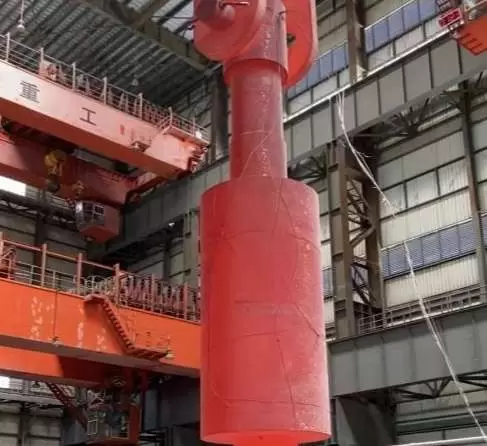Why Large Forging for Oil and Gas Pipe Fittings Is Essential to Pipeline Performance
2025-07-25
In the high-stakes environment of oil and gas operations, component failure is not an option. Every element in a pipeline system must deliver maximum strength, safety, and longevity under extreme pressures and temperatures. Among all critical components, large forging for oil and gas pipe fittings plays an irreplaceable role. These heavy-duty forged fittings are engineered to ensure long-term integrity and operational efficiency in upstream, midstream, and downstream applications. From offshore platforms to refineries, large forged pipe fittings are essential for reliable flow control and leak-free operation. This article Longteng explains why large forging for oil and gas pipe fittings is the preferred solution for energy infrastructure projects and what to consider when sourcing them globally.
What Is Large Forging for Oil and Gas Pipe Fittings?

Large forging for oil and gas pipe fittings refers to the manufacturing process in which massive metal blocks—ranging from hundreds of kilograms to multiple tons—are shaped under high pressure and temperature to form elbows, tees, reducers, flanges, and connectors. These fittings are designed to handle high-pressure flow, corrosive media, and wide temperature fluctuations commonly found in oil and gas systems. Unlike casting or welding, forging reorients the grain structure of the metal to follow the geometry of the component, improving strength and eliminating internal defects. The result is a dense, high-integrity fitting capable of withstanding mechanical shock, vibration, and prolonged pressure cycling in the harshest industrial environments. Forged pipe fittings created through large-scale forging are ideal for situations where standard off-the-shelf solutions cannot offer the necessary resilience, dimensional range, or metallurgical characteristics. Whether deployed in offshore subsea manifolds or high-pressure refining systems, these fittings are the foundation of dependable fluid transport.
Advantages of Using Large Forging for Oil and Gas Pipe Fittings
Unmatched Strength and Impact Resistance
Forged pipe fittings exhibit high tensile and yield strength due to the refined grain flow achieved during deformation. This is especially crucial in subsea pipelines, high-pressure compressor lines, and hydrocarbon injection systems where mechanical fatigue is a serious concern. In such systems, even a minor flaw can lead to catastrophic failure, shutdowns, or safety hazards. The use of large forging for oil and gas pipe fittings ensures that each component maintains structural coherence and can endure repeated stress cycles without cracking or distortion.
In environments prone to seismic activity or strong wave impacts, such as offshore drilling rigs or floating LNG platforms, forged fittings add an extra layer of protection. Their ability to absorb kinetic energy and resist brittle failure under extreme dynamic loads makes them the top choice for challenging environmental conditions. Additionally, the controlled deformation during forging aligns the metal grain to follow the shape of the fitting, adding directional strength where it’s most needed.
Superior Pressure and Temperature Performance
Large forging for oil and gas pipe fittings allows these components to maintain structural integrity in environments exceeding 15,000 psi and temperatures up to 800°C. Forged fittings are commonly used in wellhead systems, gas separation units, and steam generation lines because of this robust performance. These fittings often form part of safety-critical systems, where pressure loss or rupture can have environmental and operational consequences.
The forging process ensures that critical stress points, such as joints and bends, are free of inclusions or voids. This mechanical purity enhances the safety profile of oil and gas networks, especially in high-temperature steam or sour gas systems. Forged pipe fittings are also more stable under thermal cycling, reducing the risk of fatigue cracking or flange face deformation when exposed to fluctuating operational conditions.
Resistance to Corrosion and Erosion
When manufactured from stainless steel, duplex, or nickel alloys, forged fittings are highly resistant to internal corrosion, scaling, and pitting. This makes them ideal for sour gas, hydrogen sulfide service, or offshore seawater injection lines. Corrosion can significantly reduce wall thickness over time, leading to safety risks and unplanned downtime; thus, material selection in large forging for oil and gas pipe fittings is a core engineering decision.
Forged pipe fittings can also be treated with corrosion-resistant overlays or claddings for extended protection. In deepwater or arctic conditions, where saltwater exposure is constant, such measures significantly increase service life. Combined with proper heat treatment and passivation, forged components provide long-term resilience against electrochemical attack and flow-induced erosion.
Dimensional Precision and Consistency
Large forging for oil and gas pipe fittings supports tight dimensional control during production, enabling precise fit-up, better weldability, and compliance with ASME, API, and ISO standards. Forged components can achieve tolerances within millimeters, even for parts with large diameters or complex geometries.
The repeatability of forged components also reduces installation errors and on-site modification. Project timelines are shortened, and overall labor costs are reduced, making forged fittings not only reliable but also economically advantageous. Furthermore, tight dimensional control ensures that gaskets and sealing surfaces match perfectly, reducing the risk of leaks during operation and enhancing the integrity of welded joints in critical applications.
For critical oil and gas applications, reliability starts with the right components. Large forging for oil and gas pipe fittings provides the strength, precision, and durability needed to withstand extreme pressures, temperatures, and corrosive environments. From upstream drilling to downstream refining, forged fittings deliver consistent performance and long service life. Choosing high-quality forged solutions is not only a technical necessity but also a smart investment in operational safety and efficiency.





















 Email
Email